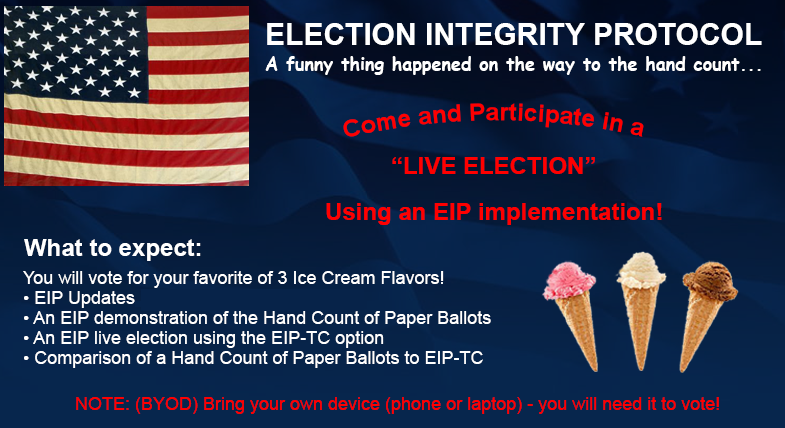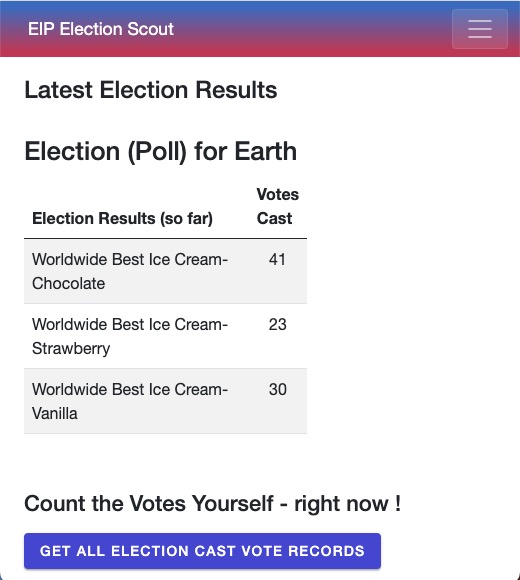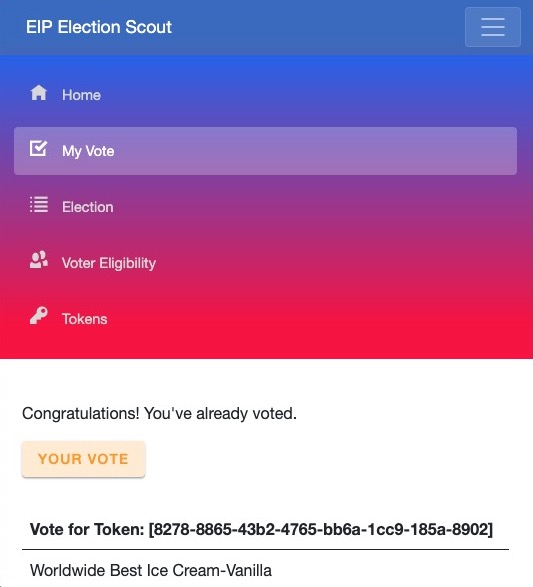On Tuesday, August 22, 2023 the world experienced the 1st group use of the Election Integrity Protocol. About 60 people gathered in Colorado Springs on relatively short notice to vote for the "World's Greatest Ice Cream".

This election (essentially a poll) was held using the EIP-TC implementation with the Vetting module disabled. This allowed the election to focus only on ballot assignment and vote counting because there was no value to be added to vet ice cream voters and out of respect for people's time. It was the beginnings of a breakthrough in both Computer Science and Election Technology. Amazing.
For those anxiously awaiting the results, here they are:

Each voter received their permanent token they can use now and forevermore to trace their vote:

Before the poll was taken, the orator presented an EIP overview with a focus on comparing the EIP-TDL (a token based machine count using distributed ledgers) process with that of an EIP-HCPB process (a canonical hand count of paper ballots) as promised. Since EIP is based on hand counts (the original "gold standard"), the process is logically the same, but the implementations vary wildly. For example, EIP-T* is scalable to millions of voters where hand counts are not at all scalable.
Let's look at what Hand Counts (EIP-HCPB) and a new form of machine count (EIP-T*) have in common, and also see where they vary.
The first thing to understand is that all forms of the EI Protocol using Secret Ballots require the physical presence of the voter. There’s no such thing as voting entirely remotely in this context. There never has been (see “Absentee Voting” on this web site). So every election of this type requires the physical presence of the voter. That really shouldn’t come as a surprise to anybody - and for those who have perpetuated the myth that absentee voting is possible for a secret ballot election, shame on you.
Next, all elections follow a prescribed process. This should also come as no surprise and is at least vaguely familiar to most people.
The 4 Stages of an Election
Every election in the world goes through 4 gated stages:
Vetting (determining voter eligibility)
Issuing (of Ballots)
Electing (the act of voting)
Counting (of Votes)
1. Vetting
________________
When comparing EIP-T* to hand counts, the vetting process is basically the same, except that EIP advocates for the outright elimination of all voter rolls in favor of replacing them with vetting rolls created for each election. Data does not have the opportunity to become stale and unnecessary data is not collected (such as which party one may be "registered" for). That's nobody's business but the voter's! Finally, voters can register far in advance of any election. All this contention around when to register to vote becomes relatively meaningless - register early, register same day - it doesn't matter! Although the vetting rolls are technically driven by outside entities, hand counts don't really try to have a say in how they are implemented. EIP-T* does in the sense that they are opinionated about it and offer a solution.
>> EIP-T* offers flexibility in when you can register to vote. Most people would prefer to register to vote on their own schedule. Isn't that a relief? EIP-T* can make that happen!
2. Issuing
________________
In a hand count (EIP-HCPB), paper ballots are issued, one to each voter. Paper ballots are physical assets. Some feel this is useful because you can always "redo" the election and they are difficult to alter. On the other hand, they can easily be destroyed and must be protected from that, which is costly. EIP-T* takes a different approach. From an electronic ballot, each vote is deemed an immutable record that is easily verified, and so the storage medium is irrelevant. Your vote is more like a bank statement transaction - it’s a permanent public record you can always retrieve and it can be stored anywhere and everywhere. No need to kill so many trees, after all.
Using EIP-T*, tokens (voter tracking numbers) are issued one to each voter. Each token belongs to the voter forevermore, and only they can use it to vote. After or during the election, it is used to view their ballot on a device of their choosing (print it out if you really want a paper copy) and to access their vote after they have voted so they can verify and count their own vote if they want to. Finally, it is used to track their vote on the global Cast Vote Ledger for the election.
>> Can you track your vote using hand counts?? NO !
This is where EIP-T* really begins to outshine hand counts.
3. Electing
__________________
In a hand count (EIP-HCPB), voters move to a voting booth which takes up space and must typically be rented or donated - if not for voting, certainly for counting (the next stage). With EIP-T*, the voter votes from a device of their own (BYOD) or they may use a terminal provided by election staff. The voter could actually take their ballot with them and vote later, if they chose to. But better to get it over with while registrars are present so they can receive vote confirmation, if desired. Finally, all this contention around when to vote becomes relatively meaningless - vote early, vote same day - it doesn't matter!
>> Again, EIP-T* rolls over hand counts because of the speed, added convenience and flexibility in when you can vote. Most people would prefer to vote quickly and efficiently on their own schedule. Isn't that a relief? EIP-T* makes that happen!
4. Counting
_____________________
In a hand count (EIP-HCPB), completed ballots are transferred to a Teller Committee who takes on the arduous responsibility for counting the votes on the paper ballots. This is a time and space consuming process that requires manpower and adequate training. It's not rocket science, but it is a lot of work that becomes completely unnecessary when using EIP-T*.
With EIP-T*, the token (vote tracking number or VTN) plays the role of the teller committee. The counting is done instantly and automatically in milliseconds. This stage requires no work at all from human beings (although it can if you choose to count the votes yourself). For consensus, potentially millions of other voters and organizations are counting all the votes at the same time. The voter's vote is available along with the progress of the election, in the palm of their hand - instantly! Furthermore, the voter can download the entire election and count the votes themselves!
>> This is a game changer - who in the world wouldn't want to track their vote?! Or monitor the election in real time (assuming that is allowed)? Or download the entire election and count the votes themselves? Once again, EIP-T* outshines hand counts, blowing it out of the water!
Summary
In summary, we walked through the voting process for both of these different implementations of the same protocol in order to see how they work to achieve the same outcome. Properly implemented, the result is the same. The more familiar (old school) hand count of paper ballots (EIP-HCPB) provides a consensus based, time-tested manner in which to run an election. It operates according to the EI protocol because the protocol was literally derived from the hand count process in the first place! This newer implementation (EIP-T*) also satisfies the protocol and has the same result, except at a much faster pace requiring fewer resources while providing additional important capabilities that are simply not possible without using machines. They both require human observation from opposing parties and that is the key to their success. You can’t have a valid election without people present to observe it!
The point is you can operate using either paper or machines and still have a successful election, provided the EI protocol is used. Which approach the community chooses is up to the people. In other words, the protocol can be satisfied either with paper ballots or with machines. And that’s really the other point: there is no reason to fear machines when they are used solely as calculators and the vote count is 100% transparent. In fact, with machines used properly, machines are arguably a better solution. It’s like a hand count of paper ballots without a hand count or paper ballots!
But people are free to choose whichever version they prefer or are more comfortable with. And for those who don’t have a choice because laws are in place to force them to use absentee voting (by way of mail-in ballots and drop boxes) or are forced to use black box scanning machines, the newer environmentally friendly version stands a much more likely chance of gaining popular success - particularly for younger populations that prefer devices and for those who don’t want to hassle with the work that is required to coordinate a teller committee.
Let the people decide!
So Now What?
Overall, it was a successful evening. Many folks expressed gratitude for the technology and were enthusiastically supportive. Folks across the country can begin implementing EIP right now. Simply get in touch with us on the sign-up page.
But what about Colorado and any other states stuck with mail-in ballots & drop boxes? While it was an informative exercise to compare two different EIP implementations (hand counts versus tokenized machine counts), the question for those is, what are the next steps? For those in this predicament that wish to return to hand counted paper ballots, I’m afraid we’ve got some bad news for you for a couple of reasons. First of all, the powers that be in both parties are highly unlikely to allow that to occur because they both benefit from the status quo. This avenue has already been approached and gotten nowhere. Not to say that people shouldn't stop trying, but in order to get paper ballots back in play, you have to win some elections. And since you can’t win elections, you’re never gonna get them back.
However, the capabilities of EIP-T* offer a path forward in that direction if people can get the word out. We believe that the benefits of being able to track your vote, see the election in real time and be assured that the vote count is accurate will ultimately outweigh the convenience of mail-in voting and drop boxes. If this implementation of EIP can replace absentee voting and single vendor counting machines, then the people can decide if they want paper ballots or not.
And finally, EIP provides an absentee voting protocol for secret ballot elections, but that requires operating in a degraded mode. We intentionally do not promote this option because it’s not the best given the alternatives available, but it can be implemented. Contact us for details.
So it all boils down to promoting EIP !
Let’s get to work!
_________________
Notes:
EIP-T* means every EIP token-based implementation
EIP-C is the centralized store implementation
BYOD - Bring Your Own Device